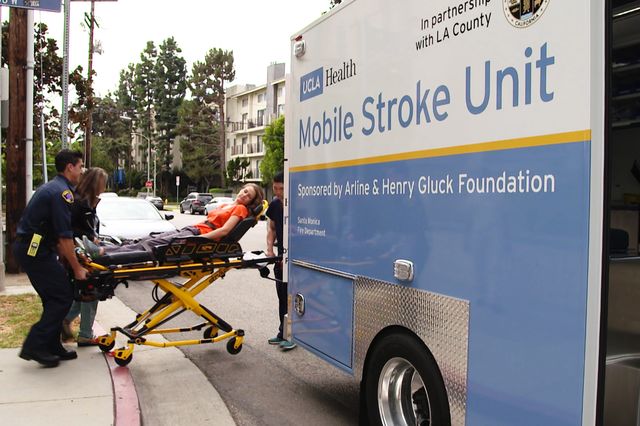UCLA partnered with Los Angeles County and Los Angeles Regional Interoperable Communications System (LA-RICS) to launch a program that delivers time-sensitive treatment to stroke victims.
As part of the first phase of a pilot program, the specialized ambulance unit and highly trained personnel began responding in September to select 911 calls in Santa Monica in coordination with the Santa Monica Fire Department.
With support from the Los Angeles County Board of Supervisors, the unit’s range will soon expand to other parts of Los Angeles County, possibly including Compton, Carson, Long Beach and Westwood. Ultimately, program organizers hope, the unit will operate in other areas of the county and may be the first of a fleet of four to nine units serving the entire county.
A mobile stroke unit is a unique type of ambulance equipped with a mobile CT scanner, which allows doctors to diagnose and treat strokes in the field with appropriate medications. Within the unit are a mobile blood-testing laboratory, as well as a neurologist, critical care nurse, CT technologist and paramedic. Patient data is collected and secure medical information is sent over the wireless LA-RICS public-safety broadband network to a stroke neurologist at UCLA Medical Center for diagnoses and subsequent treatment.
In the initial phase of the pilot program, a neurologist specializing in stroke treatment will be riding in the unit. As the program develops, however, a neurologist will oversee care more efficiently via a live video and voice connection from Ronald Reagan UCLA Medical Center.
The UCLA unit is the first such unit to operate in California. It will be the West Coast anchor of the first national demonstration project to gather data on the degree of improved patient outcomes and cost-effectiveness with accelerated field treatment. Positive results from the study could enable the federal Centers for Medicare and Medicaid Services and other insurers to reimburse emergency medical service and hospital systems for mobile stroke clinical activities.
The design, build and clinical rollout of the unit were supported by a philanthropic donation to UCLA by the Arline and Henry Gluck Foundation. “Helping make this mobile stroke unit possible for the people of Los Angeles, and to support the research into this type of care, is such a privilege,” said business executive and philanthropist Henry Gluck, who is also chair of the UCLA Health System Board. “Through this, we can save lives today, while improving care in the future.”
This past summer, the Los Angeles County Board of Supervisors voted to provide additional funding of nearly $1.5 million to enable the state-of-the-art vehicle to operate every week, instead of the original plan to operate every other week and to extend the life of the pilot program from 18 to 30 months. The additional funding also will increase the geographic reach of those served by the unit and enhance the quality of data gathered through the project.
“Minutes matter when it comes to treating strokes,” said Supervisor Janice Hahn, who wrote the motion for funding. “With a mobile stroke unit operating in L.A. County, doctors will be able to diagnose and treat stroke patients faster than ever before — making it more likely that they not only survive but go on to live longer, healthier lives.”
The motion passed by the Board of Supervisors specifically directs funding to expand the stroke unit program. The funding will come from Measure B, a county parcel tax dedicated to supporting emergency and trauma services.
“Santa Monica is proud to be a partner in bringing this life-saving resource directly to our residents and neighbors when minutes count,” Santa Monica Mayor Ted Winterer said. “The Santa Monica Fire Department has embraced this partnership from the beginning and we’re thrilled to see the mobile stroke unit launch.”
Credit: Mission Critical Communications (via Khalil Ladjevardi, SCMA Member), and UCLA Newsroom
